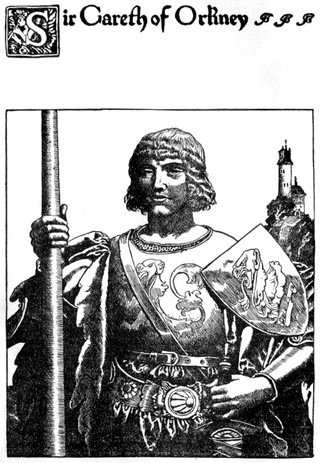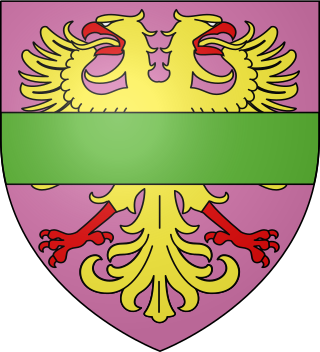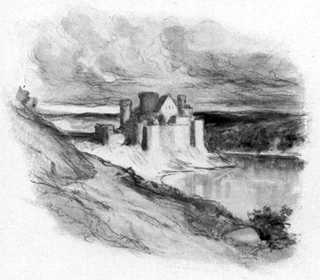This article needs additional citations for verification .(February 2024) |
Lancelot de Saint-Maard (died 1278) was the fourteenth marshal of France at the time of the Eighth Crusade in 1270. [1]
This article needs additional citations for verification .(February 2024) |
Lancelot de Saint-Maard (died 1278) was the fourteenth marshal of France at the time of the Eighth Crusade in 1270. [1]
Lancelot followed Louis IX to Africa with five knights in that year. He distinguished himself in the assault on Carthage. He conducted the siege and led the charge. During a mêlée , his helm was broken and he was saved by his fellow great officer Imbert de Beaujeu, the constable of France.

The Holy Grail is a treasure that serves as an important motif in Arthurian literature. Various traditions describe the Holy Grail as a cup, dish, or stone with miraculous healing powers, sometimes providing eternal youth or sustenance in infinite abundance, often guarded in the custody of the Fisher King and located in the hidden Grail castle. By analogy, any elusive object or goal of great significance may be perceived as a "holy grail" by those seeking such.

Guinevere, also often written in Modern English as Guenevere or Guenever, was, according to Arthurian legend, an early-medieval queen of Great Britain and the wife of King Arthur. First mentioned in popular literature in the early 12th century, nearly 700 years after the purported times of Arthur, Guinevere has since been portrayed as everything from a fatally flawed, villainous and opportunistic traitor to a noble and virtuous lady. Many records of the legend also feature the variably recounted story of her abduction and rescue as a major part of the tale.

Gawain, also known in many other forms and spellings, is a character in Arthurian legend, in which he is King Arthur's nephew and one of the premier Knights of the Round Table. The prototype of Gawain is mentioned under the name Gwalchmei in the earliest Welsh sources. He has subsequently appeared in many Arthurian tales in Welsh, Latin, French, English, Scottish, Dutch, German, Spanish, and Italian, notably as the protagonist of the Middle English poem Sir Gawain and the Green Knight. Other works featuring Gawain as their central character include De Ortu Waluuanii, Diu Crône, Ywain and Gawain, Golagros and Gawane, Sir Gawain and the Carle of Carlisle, L'âtre périlleux, La Mule sans frein, La Vengeance Raguidel, Le Chevalier à l'épée, Le Livre d'Artus, The Awntyrs off Arthure, The Greene Knight, and The Weddynge of Syr Gawen and Dame Ragnell.

Lancelot du Lac, alternatively written as Launcelot and other variants, is a popular character in Arthurian legend's chivalric romance tradition. He is typically depicted as King Arthur's close companion and one of the greatest Knights of the Round Table, as well as a secret lover of Arthur's wife, Guinevere.

Chrétien de Troyes was a French poet and trouvère known for his writing on Arthurian subjects such as Gawain, Lancelot, Perceval and the Holy Grail. Chrétien's chivalric romances, including Erec and Enide, Lancelot, Perceval and Yvain, represent some of the best-regarded works of medieval literature. His use of structure, particularly in Yvain, has been seen as a step towards the modern novel.

The Knights of the Round Table are the legendary knights of the fellowship of King Arthur that first appeared in the Matter of Britain literature in the mid-12th century. The Knights are an order dedicated to ensuring the peace of Arthur's kingdom following an early warring period, entrusted in later years to undergo a mystical quest for the Holy Grail. The Round Table at which they meet is a symbol of the equality of its members, who range from sovereign royals to minor nobles.

Gareth is a Knight of the Round Table in Arthurian legend. He is the youngest son of King Lot and Queen Morgause, King Arthur's half-sister, thus making him Arthur's nephew, as well as brother to Gawain, Agravain and Gaheris, and either a brother or half-brother of Mordred. Gareth is particularly notable in Le Morte d'Arthur, where one of its eight books is named after and largely dedicated to him, and in which he is also known by his nickname Beaumains.

Bors is the name of two knights in Arthurian legend, an elder and a younger. The two first appear in the 13th-century Lancelot-Grail romance prose cycle. Bors the Elder is the King of Gaunnes (Gannes/Gaunes/Ganis) during the early period of King Arthur's reign, and is the brother of King Ban of Benoic and the father of Bors the Younger and Lionel. His son Bors the Younger later becomes one of the best Knights of the Round Table and participates in the achievement of the Holy Grail.

Dom Bernard de Montfaucon, O.S.B. was a French Benedictine monk of the Congregation of Saint Maur. He was an astute scholar who founded the discipline of palaeography, as well as being an editor of works of the Fathers of the Church. He is regarded as one of the founders of the modern discipline of archaeology.
Ban of Benoic is a character in Arthurian legend. King Ban first appeared by this name in the Lancelot propre part of the 13th-century French Vulgate Cycle as the ruler of the realm in France named Benoic and father of Sir Lancelot and Sir Hector de Maris, as well as brother of King Bors. Ban of Benoic largely corresponds to the other versions of the father of Lancelot, including Pant of Gen[n]ewis in the German Lanzelet, Haud of Schuwake in the English Sir Lancelot du Lake, and Domolot of Lokva in the Belarusian Povest' o Tryshchane.

Gaheris is a Knight of the Round Table in the chivalric romance tradition of Arthurian legend. A nephew of King Arthur, Gaheris is the third son of Arthur's sister or half-sister Morgause and her husband Lot, King of Orkney and Lothian. He is the younger brother of Gawain and Agravain, the older brother of Gareth, and half-brother of Mordred. His figure may have been originally derived from that of a brother of Gawain in the early Welsh tradition, and then later split into a separate character of another brother, today best known as Gareth. German poetry also described him as Gawain's cousin instead of brother.

Agravain is a Knight of the Round Table in Arthurian legend, whose first known appearance is in the works of Chrétien de Troyes. He is the second eldest son of King Lot of Orkney with one of King Arthur's sisters known as Anna or Morgause, thus nephew of King Arthur, and brother to Sir Gawain, Gaheris, and Gareth, as well as half-brother to Mordred. Agravain secretly makes attempts on the life of his hated brother Gaheris starting in the Vulgate Cycle, participates in the slayings of Lamorak and Palamedes in the Post-Vulgate Cycle, and murders Dinadan in the Prose Tristan. In the French prose cycle tradition included in Thomas Malory's Le Morte d'Arthur, together with Mordred, he then plays a leading role by exposing his aunt Guinevere's affair with Lancelot, which leads to his death at Lancelot's hand.

The Lancelot-Grail Cycle, also known as the Vulgate Cycle or the Pseudo-Map Cycle, is an early 13th-century French Arthurian literary cycle consisting of interconnected prose episodes of chivalric romance originally written in Old French. The work of unknown authorship, presenting itself as a chronicle of actual events, retells the legend of King Arthur by focusing on the love affair between Lancelot and Guinevere, the religious quest for the Holy Grail, and the life of Merlin. The highly influential cycle expands on Robert de Boron's "Little Grail Cycle" and the works of Chrétien de Troyes, previously unrelated to each other, by supplementing them with additional details and side stories, as well as lengthy continuations, while tying the entire narrative together into a coherent single tale. Its alternate titles include Philippe Walter's 21st-century edition Le Livre du Graal.

Medieval French literature is, for the purpose of this article, Medieval literature written in Oïl languages during the period from the eleventh century to the end of the fifteenth century.

Lancelot, the Knight of the Cart, is a 12th-century Old French poem by Chrétien de Troyes, although it is believed that Chrétien did not complete the text himself. It is one of the first stories of the Arthurian legend to feature Lancelot as a prominent character. The narrative tells about the abduction of Queen Guinevere, and is the first text to feature the love affair between Lancelot and Guinevere.

The Post-Vulgate Cycle, also known as the Post-Vulgate Arthuriad, the Post-Vulgate Roman du Graal or the Pseudo-Robert de Boron Cycle, is one of the major Old French prose cycles of Arthurian literature from the early 13th century. It is considered essentially a rewriting of the earlier and more popular Vulgate Cycle, with much left out but also much added, including characters and scenes from the Prose Tristan. The cycle has not survived in any manuscript in its entirety and has been reconstructed from fragments in various languages.
Josephus, also called Josephe or Josephes, is the son of Joseph of Arimathea and an early keeper of the Holy Grail in some tellings of the Arthurian legend. He makes appearances in the Quest del Saint Graal section of the Lancelot-Grail cycle, but his story is fully told in the Estoire del Saint Grail, a prequel section written somewhat later. In the Estoire, he is invested as bishop by an apparition of Jesus with the implication that he was the first to receive his orders. Josephus is considered the primary holy man of the group, which is in contrast with the Lancelot-Grail's major source, Robert de Boron's Joseph d'Arimathie, in which his father is the undisputed leader. This is likely due to the authors' assertion that various great families are descended from Joseph; his virtuous son remains chaste and has no children.

Corbenic is the name of the Grail castle, the edifice housing the Holy Grail in Arthurian legend. It is a magical domain of the Grail keeper, often known as the Fisher King. The castle's descriptions vary greatly in different sources, and it first appears by that name in the Lancelot-Grail cycle where it is also the birthplace of Galahad.

Lancelot Blondeel, also Lanceloot, was a Flemish artist active in Bruges. He worked as a painter, architect, city planner, surveyor and cartographer, and designed sculptures, tapestries and jewelry.
Sebile, alternatively written as Sedile, Sebille, Sibilla, Sibyl, Sybilla, and other similar names, is a mythical medieval queen or princess who is frequently portrayed as a fairy or an enchantress in the Arthurian legend and Italian folklore. She appears in a variety of roles, from the most faithful and noble lady to a wicked seductress, often in relation with or substituting for the character of Morgan le Fay. Some tales feature her as a wife of either King Charlemagne or Prince Lancelot, and even as an ancestor of King Arthur.